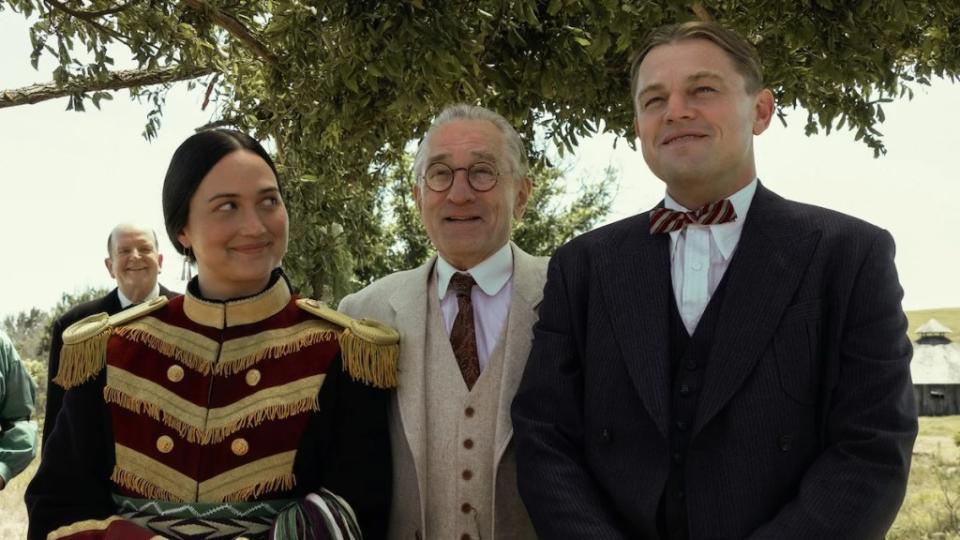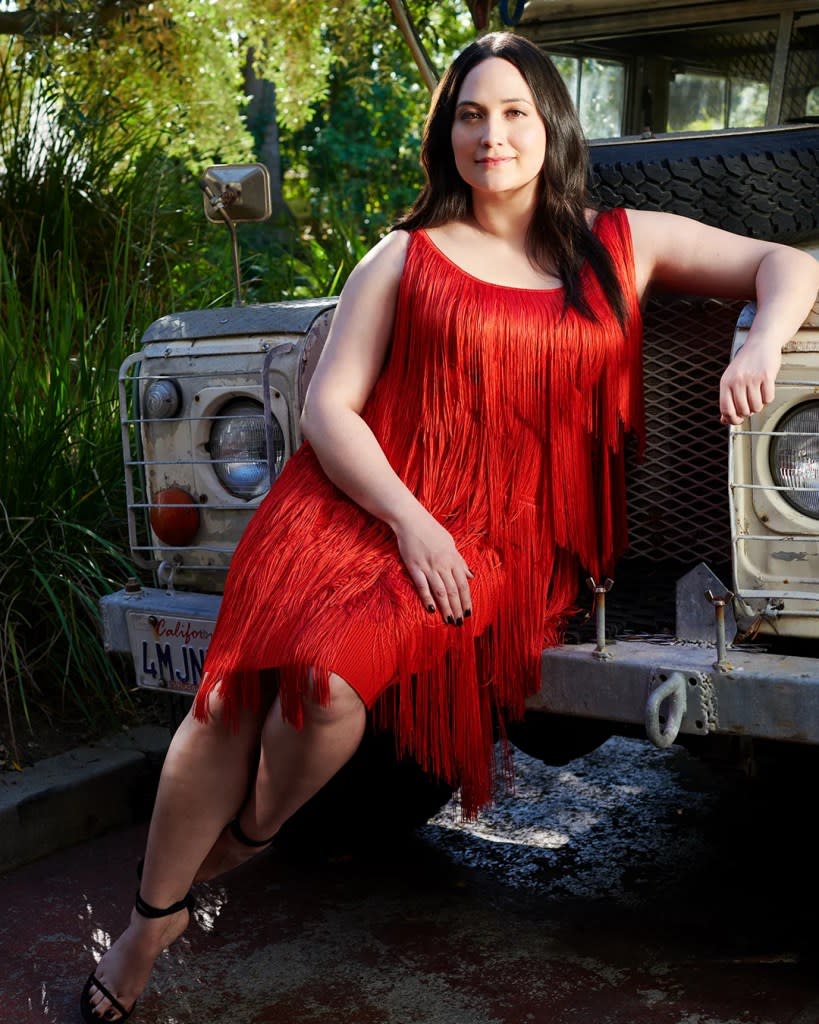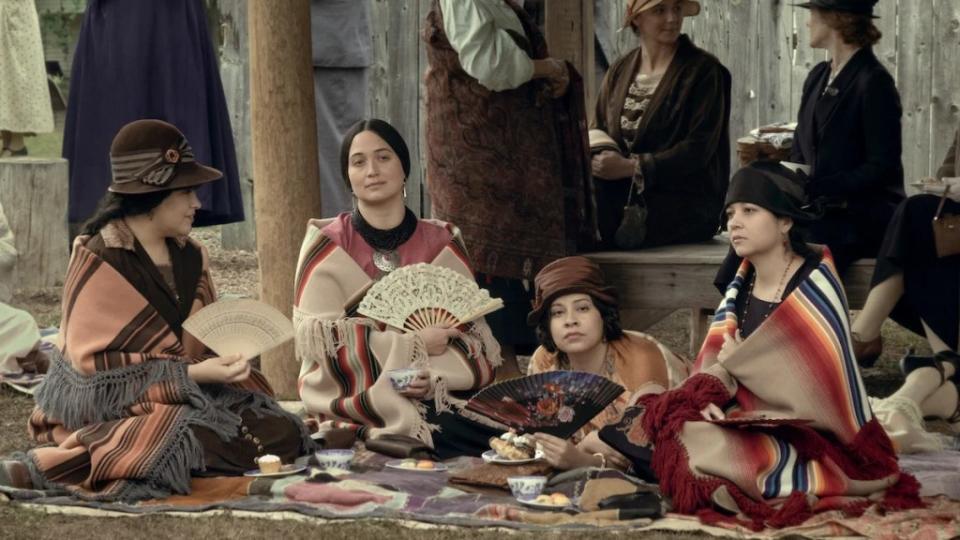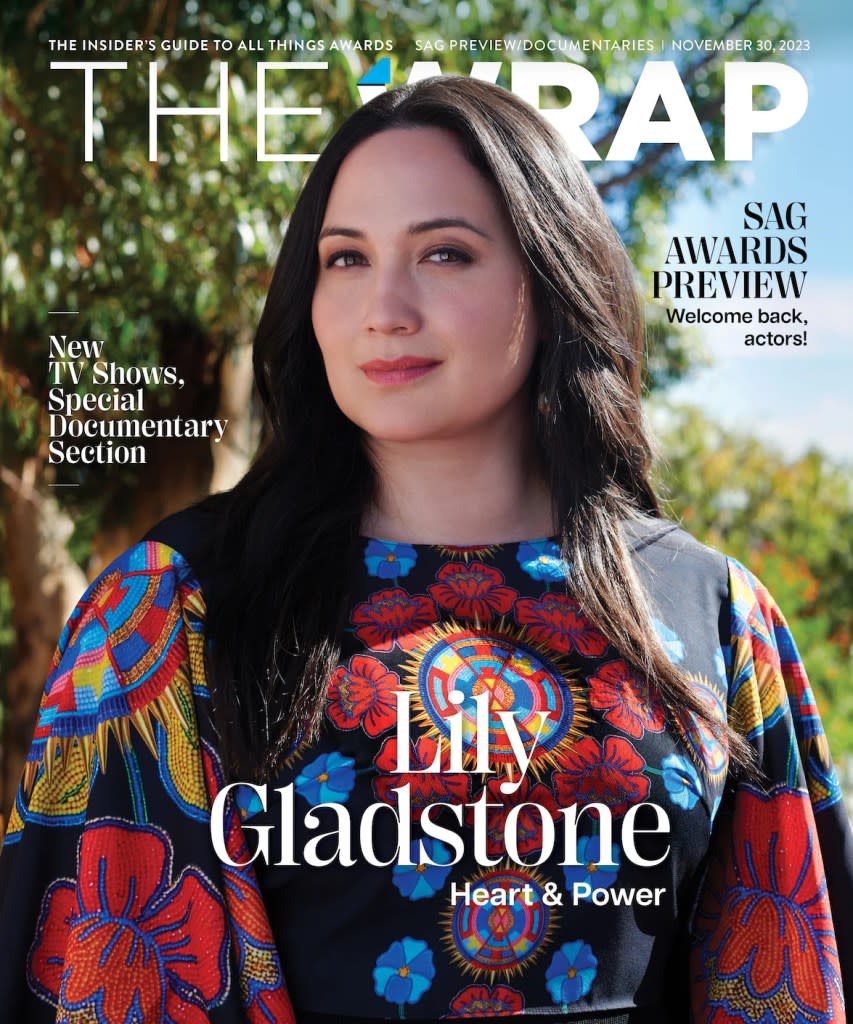Lily Gladstone on Her Journey Into the Mainstream With ‘Killers of the Flower Moon’: ‘I’m in a Better Position to Advocate’
- Oops!Something went wrong.Please try again later.
- Oops!Something went wrong.Please try again later.
- Oops!Something went wrong.Please try again later.
- Oops!Something went wrong.Please try again later.
- Oops!Something went wrong.Please try again later.
- Oops!Something went wrong.Please try again later.
“Here I am, Hollywood!”
Lily Gladstone was sitting in the front seat of a beat-up jeep on the outskirts of Los Angeles’ Griffith Park, striking a pose in a fringed red Tom Ford number and shiny spike heels, when she flung her arms wide and made that dramatic pronouncement. And then she smiled, in that Lily Gladstone way that always seems to imply that she’s in on the joke but she’s not giving too much away. You see that look a lot in Martin Scorsese’s “Killers of the Flower Moon,” the epic drama that has put this Native American actress from the Blackfeet Nation in a position where she has every right to say, “Here I am, Hollywood!”
But the smile undercut the bravado instantly, and made it clear she saw straight through to the silliness in this whole enterprise. “Did I do it right?” she asked with a chuckle. “Am I doing Hollywood right?”
Well, yeah. Lily Gladstone is doing Hollywood right — which is to say, doing it on her terms, with a sense of purpose but also a sense of humor. Before Scorsese, Robert De Niro and Leonardo DiCaprio came calling, she’d carved out a fruitful career in independent film and TV, from her Spirit Award-nominated performance in Kelly Reichardt’s “Certain Women” to a role on the series “Reservation Dogs” to this year’s understated gem “The Unknown Country,” on which she shares writing credit and for which she won a Gotham Award.
But “Killers of the Flower Moon,” a relentless three-and-a-half hour drama about the systematic killing of Osage people by white ranchers who wanted the Osage oil money in the 1920s, puts her in a different arena. As Mollie Kyle, an Osage woman who is wooed by Ernest Burkhart (DiCaprio) but then finds her health failing as her fellow Osage begin to die around her, Gladstone is a quiet center of gravity. She says a lot without saying much, and she seems to be slyly holding all the cards until she’s too weak to hold them any longer.
When I mentioned that observation, and then noted that her smile in the movie resembles the smile she’d been giving us in the photo session, Gladstone of course smiled. “I’ve been told I have a Mona Lisa smile since I was about 8 years old,” she said. “But I’m never holding all the cards.”
A pause. “I am holding some of the cards.”

What was your way into the character of Mollie? I assume that when you were cast, you did more than just study the book by David Grann that inspired the movie.
Yeah. To a degree, I felt like I knew who Mollie was. Grann drew her really well in a way that felt familiar. She was born in 1886, and my great-grandmother Lily, who I was named after, was born in 1896. Mollie was described as being a very devout Catholic, but also a very traditional Osage woman. Same with my great grandma. She wanted to be a nun before she ended up getting married off when she was 16 and having 10 kids. Devout Catholic her whole life. So a big part of my conversation with Marty was how Catholicism and the indigenous worldview at that time really worked and still do in a lot of ways.
Did you feel that you were able to serve as Mollie’s representative as this movie was being created?
In a number of ways, yeah. I really took it upon myself when I was learning the Osage language, because it’s very different than anything that I’d tried to speak before. It’s not the first time that I’ve had to sound like I’m a fluent speaker of a language that a linguist would declare a dead language. We hate that term because we’re in a language revitalization era, but Osage doesn’t have many first-language speakers today.
And what I’ve known through my interest in Blackfeet revitalization efforts is that with indigenous languages, what they really do is gift you back a worldview that lives and functions in how you speak and how you form thoughts. So in picking up Osage and in speaking with my language consultants, they were imparting some of the Osage paradigm and worldview. And there were some lines that were written from a very Western perspective that wouldn’t have made sense to Mollie at that time.
One of the biggest ones… (Laughs) I think Marty forgets sometimes that this wasn’t improv, this was a quick rewrite on my part. There was a scene of us four sisters all together talking about these [white] men, and the four of us sat down together and rewrote what we would say. But our Osage language consultants were having a hard time translating some of the things that had been written in English. One of the lines that didn’t really sit well in that particular scene was me saying that Ernest had “devil blue eyes.”
At some point I had heard a story about an Osage trickster figure, which is coyote, šǫ́mįhkase. That trickster figure in Osage oral tradition is kind of a fop. He’s hedonistic. He never wins, but he’s always getting into trouble and getting other people into trouble. Mischievous, self-serving, all of it. So when Ernest was flirting with Mollie early on, it was my idea to plant that idea: “šǫ́mįhkase,” that’s “you’re acting like a coyote.” She’s really calling him the trickster figure from the oral tradition.
We adapted it for the sister scene. And then in the other scene in the car, I fed Leo the line. And he said, “I don’t know what you just said, but it must mean ‘handsome devil.’”
Marty has been saying that Leo improvised that line and that it made you laugh.
That moment was a bit of improv, but it wasn’t Leo’s improv. It was mine. Just clarifying for the record. And my laugh was authentic, but it was Mollie’s laugh. It wasn’t Lily’s laugh.

The final scenes of “Killers” explicitly point out that the story of the Osage is one that has been told by white men. Do you feel as if you and the Osage consultants were able to make this a story that you had some authorship of as well?
Yeah, in ways. Just not being willing to adapt your language to fit what somebody else was trying to say. And the great thing there is Marty had no interest in trying to change Osage view and Osage concepts around whatever his concept was. He was eager to bend whatever his thought might have been if there was something better. And there was always something better if it was coming from Osage. I’m speaking of Yancey Red Corn and Everett Waller, who played Chief Bonnicastle and Assistant Chief Paul Red Eagle.
People don’t necessarily realize how diverse Indian country is. How we’re not a homogenized culture. There are 574 different recognized nations in this country and several hundred others that are not. So it was a refreshing and wonderful thing for me to know that there were Osage voices that were shaping what these Osage characters were saying and doing. And it was my responsibility to try and do that as much as I possibly could and to echo what I was hearing from people. So that little improv of mine that turned into a scripted line for Leo was vetted in conversation with Osages.
You mentioned my smile and Marty has mentioned my wry humor. That’s an element that I think all the Native folks who were a part of this were really excited to bring into it. Because Native people are funny, you know? We’re drawn as being very stoic, which Mollie is. She’s guarded in certain company, but she’s got a sharp sense of irony and a humorous view on life, and that’s a very cultural thing. When the camera wasn’t running, me and the other actresses were just busting out laughing all the time. It was fun to imbue that part of our worldview, which is part of the way of being that has made us so resilient through hundreds and hundreds of years of colonization.

You’re always laughing, even when you’re telling a story about the systematic murder of Native people?
Yeah. We say this all the time: We can have a real dark humor that doesn’t always play in broader society, but that’s one way you take ownership of your story. Because we’re still here. And our stories are so integrated into the fabric of American history that to not have us included in a lot of different storytelling paradigms is not good.
You now have the highest profile you’ve had in your career, even though you’ve done some great work before…
I’ve flown under the radar and kept my indie cred ’til now.
So now that you’ve blown your indie cred, what do you want to do with your mainstream cred?
That’s a great question. My “mainstream cred.” (Laughs) Yeah, I guess that bank is full and I gotta be wise in how I spend it. Where I’m finding a lot of power, if that’s even the right word, is I’m in a better position to advocate in rooms with people who can affect change immediately. I don’t necessarily like the cliché of opening doors. It’s setting the table. There’s a chance to bring community to the table in a way that I haven’t really had the influence to do before. So that’s nice.
I also would love it if there were more opportunities for Native audiences to see themselves represented in every kind of role, because that’s reality too. I think people, when they want to include Native American storylines, often feel like they have to shoehorn it in or carve a space where it would be feasible that there would be a Native person there. We’re everywhere.
(Laughs) Case in point: I met a Blackfeet man in Vienna. His great-grandmother was from Browning, Montana and was Blackfeet and went to a boarding school. She met a country boy who was a Viennese farm boy. They fell in love and they got married and then after maybe their first or second kid, they moved back with his family to Vienna. And that’s how you get a Viennese-born Blackfeet man who plays drums in a punk band and paints and is very European.
Yeah, we’re everywhere. And even if a character isn’t explicitly Native, there’s nothing to say that a Native person wouldn’t be in that position. So that’s one of my other aspirations, to help expand our lens a bit to help place us in these moments where we always should have been.
Did things like this seem feasible to you when you were in college studying film and acting?
Yeah, it made sense. I just wanted everybody else to catch up with what I knew was possible. I mean, in college, I loved Beckett, I loved Brecht. My grandmother, who was born in Lapwai on the Nez Perce reservation during the Depression, loved movies. Her hobby was taping movies. As soon as cable TV came out, we had walls full of those pullout VHS organizers that she would get at Goodwill. One tape would have four different movies and she would catalog them all. And after she typed them out, she’d use her boarding-school-perfect Catholic penmanship to fill in the margins when she’d add a new title. She was very shy, but I think she always had quiet aspirations to be a movie star. I think maybe that is where I got the acting bug.
Was she still around to know that you were making a movie with Martin Scorsese, Robert De Niro and Leonardo DiCaprio?
Yeah. She passed last summer, so she never got to see it, but she was later-stages dementia when I got cast. So it was kind of a sweet thing to deliver the news to her several times a day that I was going to be in a movie with Robert De Niro by Martin Scorsese. She couldn’t remember who Leonardo DiCaprio was, but, “Ooh, Robert De Niro!” My grandma saw “Taxi Driver” when it was in theaters. So yeah, she was very excited.
My dad told me later that he asked her once how it felt for her to know that her granddaughter was a movie star. “Ooh, it’s fantastic. I love movies!” (Laughs) It was very cute.
This story first appeared in the SAG Preview/Documentaries issue of TheWrap’s awards magazine. Read more from the issue here.
Credits
Creative Director: Jeff Vespa
Photo Editor: Tatiana Leiva
Hair: Brian Fisher
Makeup: Nick Barose for Exclusive Artists
Styling: Jason Rembert
Manicurist: Yoko Sakakura
The post Lily Gladstone on Her Journey Into the Mainstream With ‘Killers of the Flower Moon’: ‘I’m in a Better Position to Advocate’ appeared first on TheWrap.


